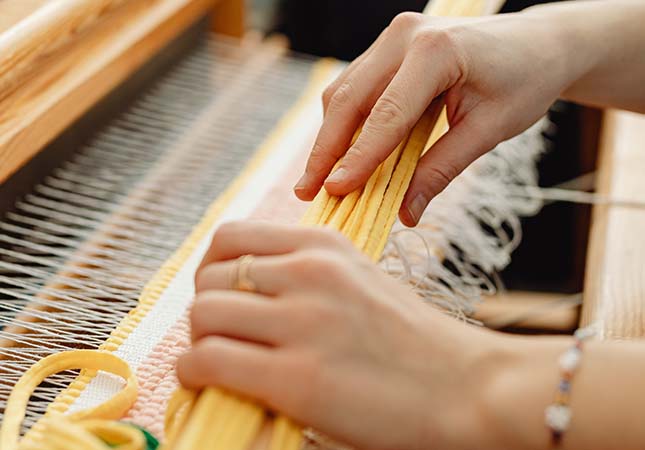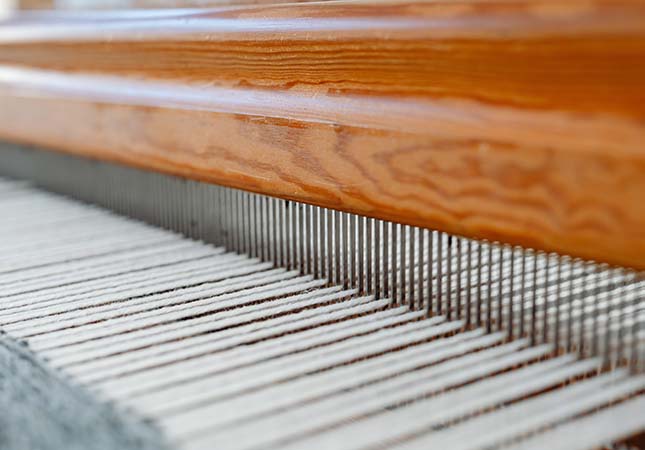A weaving machine is a complex device that is used in the textile industry to create woven fabrics. The structure of the weaving machine is complex, so learning the basic structure and ways to use the weaving machine is a must, which would help the manufacturers and the workers use it better.

The Structure of the Weaving Machine
Weaving machine has evolved significantly over time, from simple hand-operated looms to highly sophisticated automated machines. There are the structures of the weaving machine.
1. Structure of a Weaving Machine
Weaving machine has evolved significantly over time, from simple hand-operated looms to highly sophisticated automated machines.
2. Warp Beam
The warp beam is a cylindrical component that holds the warp yarns, mounted on the back of the weaving machine, and provides a continuous supply of warp yarns during the weaving process. The warp yarns are wound onto the warp beam in a parallel and tensioned manner, forming the foundation of the fabric.
3. Warp Stop Motion
The warp stop motion is a sensor system that is installed on the warp beam. It detects any breakages or irregularities in the warp yarns and stops the machine automatically to prevent further damage. It is a critical component that ensures the quality of the woven fabric.
4. Harnesses
The harnesses are frames or frames with movable parts that hold the warp yarns and control their movement during the weaving process. They are connected to a lifting mechanism that raises or lowers them to create the shed, which is the opening through which the weft yarn is inserted.
5. Reed
The reed is a comb-like component that is mounted in the front of the loom and is used to beat the weft yarns into place after they are inserted into the shed. The reed determines the density or tightness of the woven fabric.
6. Shuttle
The shuttle is a boat-shaped component that carries the weft yarn across the loom from one side to the other and moves back and forth between the warp yarns, inserting the weft yarns into the shed created by the harnesses.
7. Take-Up Mechanism
The take-up mechanism is responsible for winding the woven fabric onto a cloth beam and determines the tension and the rate of fabric take-up, which affects the fabric's characteristics, such as its density and appearance.
8. Let-Off Mechanism
The let-off mechanism controls the unwinding of the warp yarns form the warp beam and maintains the proper tension during the weaving process. It ensures a consistent supply of warp yarns to the weaving machine, which is crucial for producing high-quality fabrics.
9. Beating Mechanism
The beating mechanism, also known as the picking mechanism, is responsible for inserting the weft yarn into the shed and beating it into place with the reed, which determines the density and the alignment of the weft yarns, which affect the fabric's strength and appearance.
10. Selvage Formation Mechanism
The selvage formation mechanism is responsible for creating the selvage, which is the edge of the fabric that is finished to prevent fraying or unraveling, can be formed using various methods, such as leno selvage, tuck-in selvage, or taped selvage, depending on the desired fabric characteristics.
How the Weaving Machine Works
Weaving is a complex process that involves the interlacing of warp and weft yarns to create a fabric. The following is about how a modern weaving machine weaves fabric in detail.
1. Shedding
The first step in the weaving process is shedding, which involves creating an opening or shed through which the weft yarn is inserted. Shedding is achieved by raising or lowering the harnesses, which hold the warp yarns, using a shedding mechanism. The number and arrangement of the harnesses determine the weave pattern of the fabric. Modern weaving machine uses advanced shedding mechanisms, such as dobby or Jacquard shedding, which are controlled by computerized systems for precise and complex designs.
2. Pick Insertion
Once the shed is created, the next step is the insertion of the weft yarn, also known as pick insertion. The weft yarn is wound onto a shuttle or other weft insertion devices, which carry it across the loom from one side to the other. The shuttle passes through the shed, inserting the weft yarn, and then returns to its original position for the next pick insertion. Advanced weaving machine may use air-jet, water-jet, or rapier insertion methods instead of shuttles for faster and more efficient pick insertion.
3. Beating
After the weft yarn is inserted into the shed, the next step is to beat it into place using the reed. The reed is a comb-like component that is mounted in the front of the loom and is used to push the weft yarns tightly against the previously inserted picks, determines the density or tightness of the woven fabric, and helps to create a uniform structure.
4. Take-Up
Once the weft yarn is beaten into place, the woven fabric is advanced or taken up by the take-up mechanism. The take-up mechanism is responsible for winding the fabric onto a cloth beam, which determines the tension and the rate of fabric take-up. The tension and the rate of take-up can affect the fabric's characteristics, such as its density, appearance, and stability.
5. Selvage Formation
During the weaving process, it is important to create selvages, which are the finished edges of the fabric that prevent fraying or unraveling. selvages can be formed using various methods, such as leno selvage, tuck-in selvage, or taped selvage, depending on the desired fabric characteristics. Selvage formation mechanisms are integrated into modern weaving machines to create consistent and uniform selvages.
6. Warp Control
Ensuring proper tension and control of the warp yarns is crucial for the quality of the woven fabric. Modern weaving machine is equipped with let-off mechanisms that control the unwinding of the warp yarns form the warp beam and maintain the proper tension during the weaving process. The let-off mechanism ensures a consistent supply of warp yarns to the weaving machine, preventing warp yarn breakages or irregularities that can affect the fabric's quality.
7. Warp Stop Motion
To detect any breakages or irregularities in the warp yarns, a modern weaving machine is equipped with warp stop motion sens that are installed on the warp beam and detect any changes in the tension or movement of the warp yarns. If a warp yarn breaks or becomes irregular, the warp stop motion automatically stops the machine to prevent further damage and ensure the quality of the woven fabric.
8. Shed Control
The shedding mechanism, which controls the movement of the harnesses, is a critical part of the weaving process. Modern weaving machine uses advanced shedding mechanisms that are controlled by precision and automated.

Conclusion
In conclusion, although the consists of the weaving machine is a bit complex, it’s not difficult for us to learn it, and mastering the use stages of the weaving machine will benefit a lot for the manufacturers.




